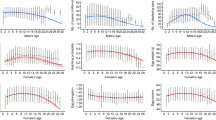Abstract
Reproductive traits are among the primary determinants of population dynamics, and their changes could affect stock size. We investigated differences in reproductive traits of the starspotted smooth-hound Mustelus manazo in Tokyo Bay between the 1990s (a low-stock period) and the 2000s (a high-stock period). Peak timings of mating (May–July), ovulation (May–June), and parturition (May–June) were similar between the two periods. However, the size at first maturity in the 2000s was smaller than that in the 1990s for both sexes. In addition, embryo-related parameters differed greatly between the two periods. Slopes of size–fecundity regression in the 2000s decreased to 43–73 % of the 1990–1996 values, suggesting a substantial decline in fecundity during the 2000s. Frequency distribution of the maximum ovum diameter during the ovulation season showed two distinct two modes in 1990s while it showed a substantial dispersion during the 2000s, implying that changes occurred in the developmental pattern of ova in the ovary. Undeveloped eggs were present in the uteri with low frequency from September to May during the 2000s, but they were totally absent from September through May in the 1990s. The increased number of remnant undeveloped eggs that did not become embryos may explain the fecundity decline during the 2000s.









Similar content being viewed by others
References
Collie JS, Wood AD, Jeffries HP (2008) Long-term shifts in the species composition of a coastal fish community. Can J Fish Aquat Sci 65:1352–1365
Kodama K, Oyama M, Lee JH, Kume G, Yamaguchi A, Shibata Y, Shiraishi H, Morita M, Shimizu M, Horiguchi T (2010) Drastic and synchronous changes in megabenthic community structure concurrent with environmental variations in a eutrophic coastal bay. Prog Oceanogr 87:157–167
Kodama K, Shiraishi H, Morita M, Horiguchi T (2006) Verification of lipofuscin-based crustacean ageing: seasonality of lipofuscin accumulation in the stomatopod Oratosquilla oratoria in relation to water temperature. Mar Biol 150:131–140
Kodama K, Shiraishi H, Morita M, Horiguchi T (2009) Reproductive biology of the Japanese mantis shrimp Oratosquilla oratoria (Crustacea Stomatopoda): annual cycle of gonadal development and copulation. Mar Biol Res 5:415–426
Kodama K, Oyama M, Lee JH, Akaba Y, Tajima Y, Shimizu T, Shiraishi H, Horiguchi T (2009) Interannual variation in quantitative relationships among egg production and densities of larvae and juveniles of the Japanese mantis shrimp Oratosquilla oratoria in Tokyo Bay, Japan. Fish Sci 75:875–886
Lee JH, Kodama K, Kume G, Oyama M, Katayama S, Takao Y, Horiguchi T (2009) Comparison between surface-reading and cross-section methods using sagittal otolith for age determination of the marbled sole Pseudopleuronectes yokohamae. Fish Sci 75:379–385
Lee JH, Kodama K, Oyama M, Kume G, Takao Y, Shiraishi H, Horiguchi T (2009) Changes in growth of marbled sole Pseudopleuronectes yokohamae between high and low stock-size periods in Tokyo Bay, Japan. Fish Sci 75:929–935
Yamaguchi A, Taniuchi T, Shimizu M (1997) Reproductive biology of the starspotted dogfish Mustelus manazo from Tokyo Bay, Japan. Fish Sci 63:918–922
Jørgensen C, Enberg K, Dunlop ES, Arlinghaus R, Boukal DS, Brander K, Ernande B, Gårdmark A, Johnston F, Matsumura S, Pardoe H, Raab K, Silva A, Vainikka A, Dieckmann U, Heino M, Rijnsdorp AD (2007) Managing evolving fish stocks. Science 318:1247–1248
Kodama K, Shimizu T, Yamakawa T, Aoki I (2006) Changes in reproductive patterns in relation to decline in stock abundance of the Japanese mantis shrimp Oratosquilla oratoria in Tokyo Bay. Fish Sci 72:568–577
Yamaguchi A, Taniuchi T, Shimizu M (1996) Age and growth of the starspotted dogfish Mustelus manazo from Tokyo Bay, Japan. Fish Sci 62:919–922
Yamaguchi A, Taniuchi T (2000) Food variations and ontogenetic dietary shift of the starspotted-dogfish Mustelus manazo at five locations in Japan and Taiwan. Fish Sci 66:1039–1048
Ratkowsky DA (1990) Handbook of nonlinear regression models. Marcel Dekker, New York
Park JC, Lee JH, Kodama K, Urushitani H, Ohta Y, Horiguchi T (2012) Structure of the intratesticular duct system for sperm emission in the starspotted smooth-hound, Mustelus manazo. Fish Sci. doi: 10.1007/s12562-012-0581-6
Conrath CL, Musick JA (2002) Reproductive biology of the smooth dogfish, Mustelus canis, in the northwest Atlantic Ocean. Environ Biol Fish 64:367–377
Yamaguchi A, Taniuchi T, Shimizu M (2000) Geographic variations in reproduction of the starspotted dogfish, Mustelus manazo, from five localities in Japan and Taiwan. Environ Biol Fish 57:221–233
Kelly KH, Stevenson DK (1985) Fecundity of Atlantic herring (Clupea harengus) from three spawning areas in the Western Gulf of Maine, 1969 and 1982. J Northw Atl Fish Sci 6:149–155
Ma Y, Kjesbu OS, Jorgensen T (1998) Effects of ration on the maturation and fecundity in captive Atlantic herring (Clupea harengus). Can J Fish Aquat Sci 55:900–908
Gregersen F, Vollestad LA, Ostbye K, Aass P, Hegge O (2011) Temperature and food-level effects on reproductive investment and egg mass in vendace, Coregonus albula. Fish Manage Ecol 18:263–269
Conover DO, Munch SB (2002) Sustaining fisheries yields over evolutionary time scales. Science 297:94–96
Walsh M, Munch SB, Chiba S, Conover DO (2006) Maladaptive changes in multiple traits caused by fishing: impediments to population recovery. Ecol Lett 9:142–148
Teshima K (1981) Studies on the reproduction of the Japanese smooth dogfishes, Mustelus manazo and M. griseus. J Shimonoseki Univ Fish 29:113–199
Taniuchi T, Kuroda N, Nose Y (1983) Age, growth, reproduction, and food habits of the star-spotted dogfish Mustelus manazo collected from Choshi (in Japanese with English abstract). Nippon Suisan Gakkaishi 49:1325–1334
Teshima K (1978) Studies on sharks-XII Monthly change of the gonad index in male Mustelus manazo and M. griseus. Jpn J Ichthyol 24:285–289
Acknowledgments
We thank Mr. Saburo Hirano, fisherman, Chiba Prefecture, for his help in collecting the specimens in Tokyo Bay.
Author information
Authors and Affiliations
Corresponding author
Rights and permissions
About this article
Cite this article
Park, JC., Oyama, M., Lee, JH. et al. Phenotypic changes in reproductive traits with changes in stock size of the starspotted smooth-hound Mustelus manazo in Tokyo Bay, Japan. Fish Sci 79, 193–201 (2013). https://doi.org/10.1007/s12562-012-0580-7
Received:
Accepted:
Published:
Issue Date:
DOI: https://doi.org/10.1007/s12562-012-0580-7




